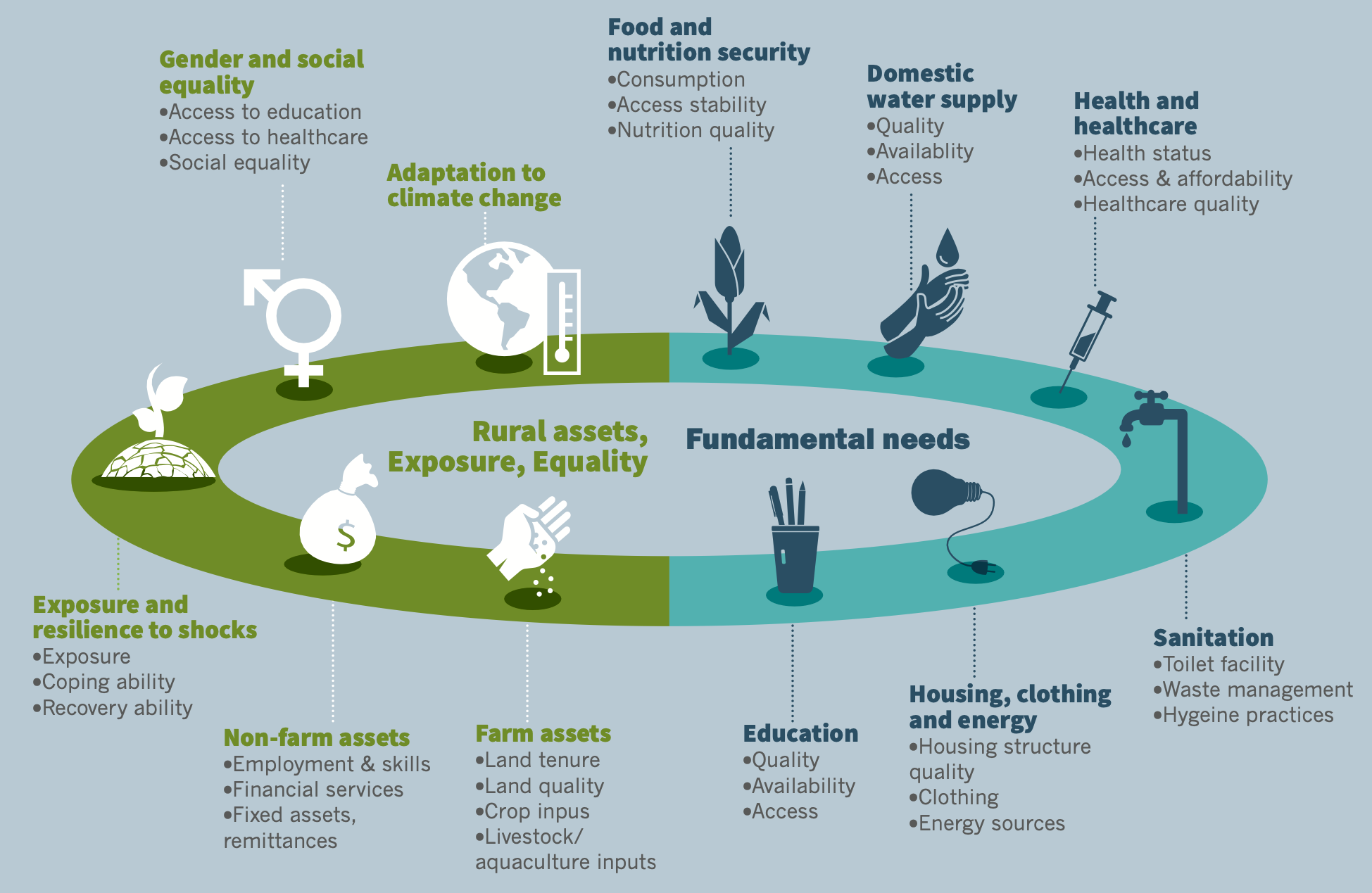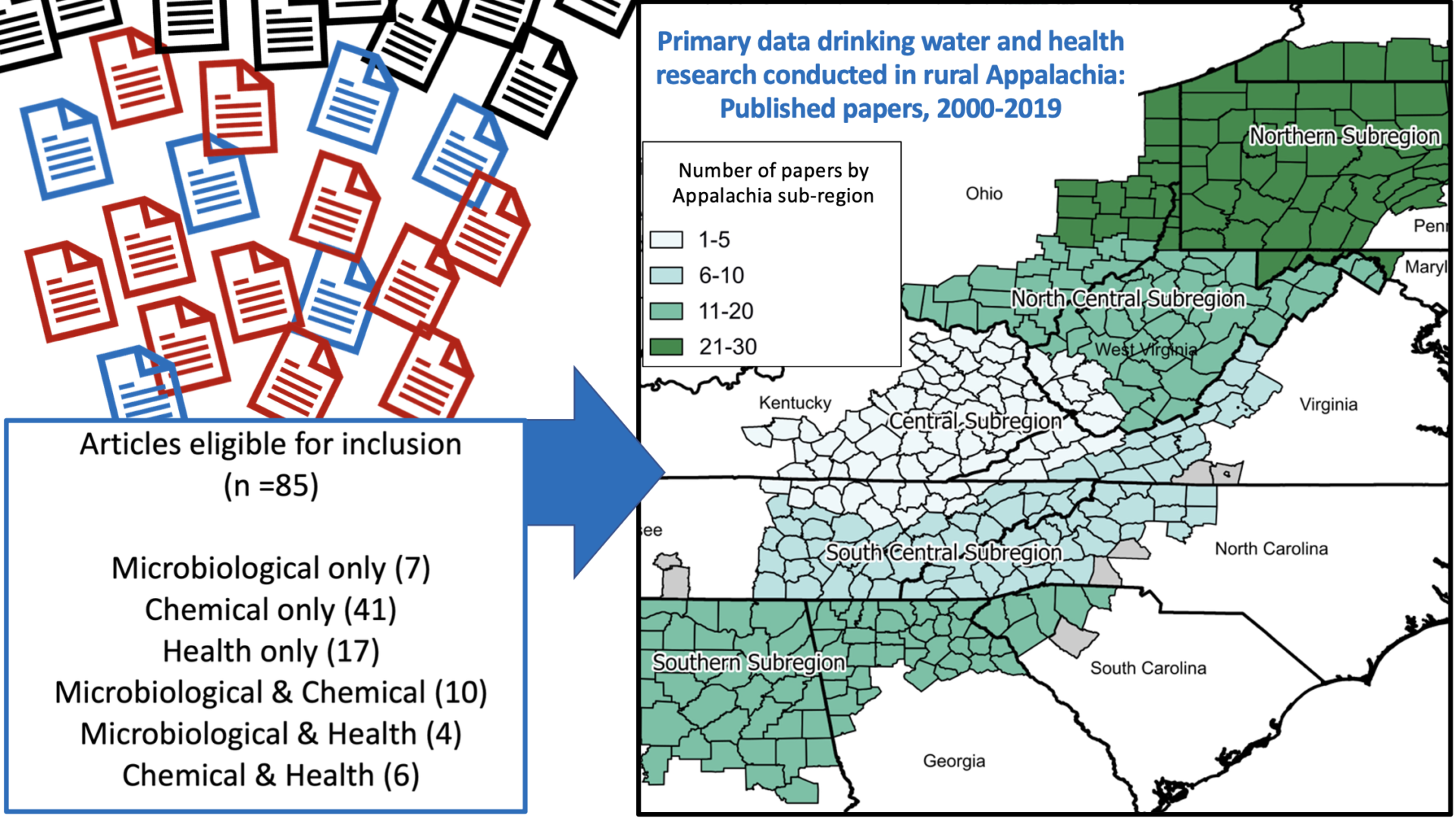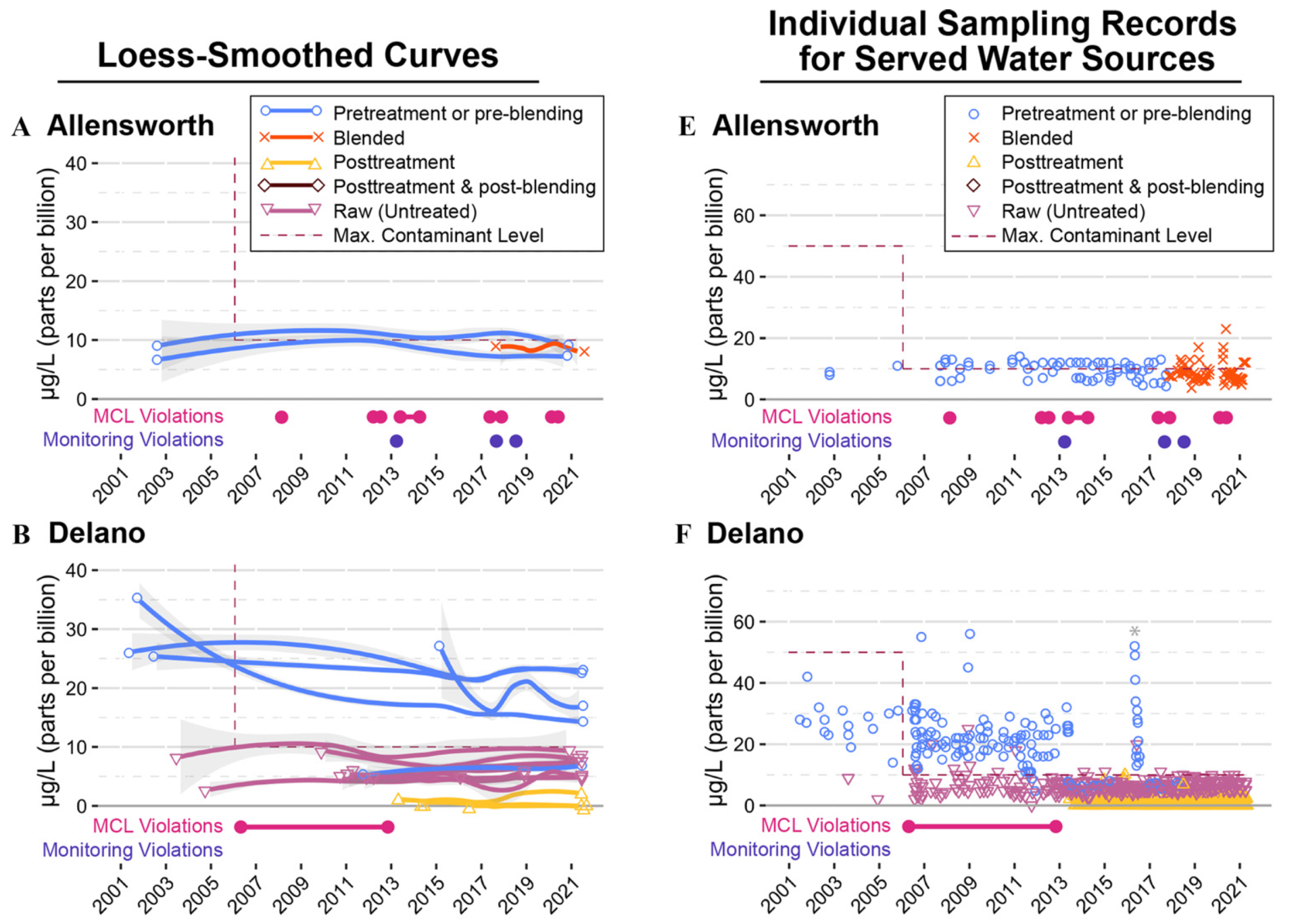Perceptions of poverty: Evaluating Multidimensional Poverty Assessment Tool derived rankings and global development indicators in five African nations
Authors: Minjauw, F., Rasheduzzaman, M., Baumgartner, P., Doward, P., Clarkson, G., & Cohen, A.*
Publication Year: 2024 | Journal / Publisher: Journal of International Development
Abstract/Summary: This study assessed an array of indicators for rural poverty assessments and evaluated use of the Multidimensional Poverty Assessment Tool (MPAT) as a proxy for commonly used indicators, such as the Human Development Index, Gross National Income, Global Hunger Index, and the Gender Inequality Index. MPAT data from 5322 rural households across five countries in Africa were analyzed. While MPAT aligned well with development indicators for Kenya, Lesotho, and Tanzania, this was not the case for Eswatini and Zimbabwe. Overall, MPAT-based rankings correlated well with hunger, food security, and gender equality indicators. Our findings highlight the use of MPAT-derived indices as valuable supplements for commonly used development indicators.
PDF on Publisher Website | PDF on OSF
Making Waves: The Benefits and Challenges of Responsibly Implementing Wastewater-based Surveillance for Rural Communities
Authors: Cohen, A., Vikesland, P., Pruden, A., Krometis, L.-A., Lee, L.M., Darling, A., Yancey, M., Helmick, M., Singh, R., Gonzalez, R., Meit, M., Degen, M., & Taniuchi, M.
Publication Year: 2023 | Journal / Publisher: Water Research
Abstract/Summary: The sampling and analysis of sewage for pathogens and other biomarkers offers a powerful tool for monitoring and understanding community health trends and potentially predicting disease outbreaks. Since the early months of the COVID-19 pandemic, the use of wastewater-based testing for public health surveillance has increased markedly. However, these efforts have focused on urban and peri-urban areas. The potential public health benefits of wastewater-based surveillance for rural communities are substantial – though so too are the methodological and ethical challenges. Practitioner observations and research findings indicate that for many rural systems, typical implementation approaches for wastewater-based surveillance will not yield sufficiently reliable or actionable results. In this paper, we discuss key challenges and potential strategies to address them. However, to support and expand the implementation of responsible, reliable, and ethical wastewater-based surveillance for rural communities, best practice guidelines and standards are needed.
PDF on Publisher Website | PDF on OSF
Microbiological and chemical drinking water contaminants and associated health outcomes in rural Appalachia, USA: A systematic review and meta-analysis
Authors: Darling A., Patton H., Rasheduzzaman M., Guevera R., McCray J., Krometis L.A., & Cohen, A.
Publication Year: 2023 | Journal / Publisher: Science of The Total Environment
Abstract/Summary: In rural areas of the United States, an estimated ~1.8 million people lack reliable access to safe drinking water. Considering the relative dearth of information on water contamination and health outcomes in Appalachia, we conducted a systematic review of primary data studies published from 2000-2019. Of the 3,452 records identified for screening, 85 met our eligibility criteria. Most studies were conducted in Northern (32%, n=27) and North Central (24%, n=20) Appalachia, and only 6% (n=5) in Central Appalachia. Across studies, E. coli were detected in 10.6% of samples. 32% (n=27) of studies assessed health outcomes, but only 4.7% (n=4) used case-control or cohort designs (all others were cross-sectional). The most commonly reported outcomes were detection of PFAS in blood serum (n=13), gastrointestinal illness (n=5), and cardiovascular-related outcomes (n=4). Overall, based on the number and quality of eligible studies identified, we could not reach clear conclusions about the state of water quality, or its impacts on health, in any of Appalachia’s subregions. More epidemiologic research is needed to understand contaminated water sources, exposures, and potentially associated health outcomes in Appalachia.
PDF on Publisher Website | PDF on OSF
The Human Right to Water: A 20-Year Comparative Analysis of Arsenic in Rural and Carceral Drinking Water Systems in California
Authors: Rempel, J., Ray, I., Hessl, E., Vazin, J., Zhou, Z., Kim, S., Zhang, X., Ding, C., He, Z., Pellow, D., & Cohen, A.
Publication Year: 2022 | Journal / Publisher: Environmental Health Perspectives
Abstract/Summary: Access to safe drinking water is considered a universal human right. In the U.S., exposure to arsenic contamination in drinking water disproportionately impacts small, groundwater-reliant communities and communities of color. Limited research exists on water quality in prisons; however, prisons in the Southwestern U.S. have elevated arsenic concentrations compared to other community water systems (CWS) in the region. In this paper we present a comparative analysis of 20 years of data (2001-2021) on arsenic concentrations in the CWSs serving Kern Valley State Prison (KVSP) and three neighboring rural communities: Allensworth, Delano, and McFarland. Our objective was to better understand trends in water quality, compliance, and treatment following adoption of the revised arsenic MCL, and to elucidate differences, if any, between neighboring incarcerated and non-incarcerated populations.
PDF on Publisher Website | PDF on OSF
Water Supply Improvement & Health Promotion Campaigns in Rural Areas — China, 1949−2020
Authors: Li, H., Cohen, A., Lin, L., Zhang, X. & Zhang, R.
Publication Year: 2021 | Journal / Publisher: China CDC Weekly
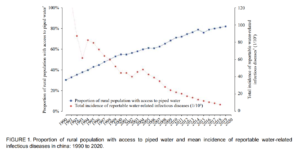 Abstract/Summary: In the 1950s, shortly after the founding of the People’s Republic of China (PRC), the central government created the Patriotic Health Campaign (PHC) in order to standardize and disseminate health focused educational materials intended to control and prevent infectious diseases (1). “Water improvement”, meaning measures aimed at providing safe drinking water for households in China, was an important part of the PHC. After 60 years of water improvement policies, programs, and investments, the rural water supply sanitation and hygiene in China has improved dramatically, and water-related diseases no longer negatively impact the rural population as they once did. In addition to improvements related to the quantity and quality of the rural water supply, water improvement programs also promoted improved hygiene, sanitation, and other health-related behaviors among rural households. Together, such initiatives have improved the quality of life and the health of hundreds of millions of rural residents, while also contributing to economic and social advancement across rural China (2). The purpose of this article is to describe how the PHC served as a foundation for the expansion and improvement of drinking water supply in rural China, and to summarize the key programs, projects, and initiatives that followed over the last 60 years.
Abstract/Summary: In the 1950s, shortly after the founding of the People’s Republic of China (PRC), the central government created the Patriotic Health Campaign (PHC) in order to standardize and disseminate health focused educational materials intended to control and prevent infectious diseases (1). “Water improvement”, meaning measures aimed at providing safe drinking water for households in China, was an important part of the PHC. After 60 years of water improvement policies, programs, and investments, the rural water supply sanitation and hygiene in China has improved dramatically, and water-related diseases no longer negatively impact the rural population as they once did. In addition to improvements related to the quantity and quality of the rural water supply, water improvement programs also promoted improved hygiene, sanitation, and other health-related behaviors among rural households. Together, such initiatives have improved the quality of life and the health of hundreds of millions of rural residents, while also contributing to economic and social advancement across rural China (2). The purpose of this article is to describe how the PHC served as a foundation for the expansion and improvement of drinking water supply in rural China, and to summarize the key programs, projects, and initiatives that followed over the last 60 years.
PDF on Publisher Website | PDF on OSF
The impacts of socioeconomic development on rural drinking water safety in China: A provincial-level comparative analysis
Authors: Li, H., Cohen, A., Li, Z., & Zhang, M.
Publication Year: 2019 | Journal / Publisher: Sustainability
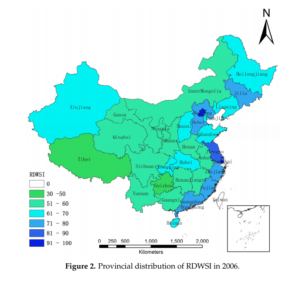 Abstract/Summary:In China, achieving rural drinking water safety—meaning access to a safe, affordable, sufficient, and sustainable drinking water supply—remains a key challenge for government agencies and researchers. Using cross-sectional data at the provincial level, in this paper we examine the impacts of socioeconomic development on drinking water safety in rural China. Using a theoretical framework called Pressure-State-Response (PSR), existing data were organized into state and pressure indicators. Canonical Correlation Analysis was then used to analyze provincial-level relationships between the indicators. Significant drinking-water-safety-related differences were found across provinces. Our analyses suggest that, overall, China’s recent and rapid socioeconomic development yielded substantial benefits for China’s rural drinking water safety. However, this same development also negatively impacted rural drinking water safety via increased groundwater over-abstraction, reductions in water supply, and environmental contamination. The paper closes with a discussion of implications and options for improving drinking water policy, management, and regulation in rural China.
Abstract/Summary:In China, achieving rural drinking water safety—meaning access to a safe, affordable, sufficient, and sustainable drinking water supply—remains a key challenge for government agencies and researchers. Using cross-sectional data at the provincial level, in this paper we examine the impacts of socioeconomic development on drinking water safety in rural China. Using a theoretical framework called Pressure-State-Response (PSR), existing data were organized into state and pressure indicators. Canonical Correlation Analysis was then used to analyze provincial-level relationships between the indicators. Significant drinking-water-safety-related differences were found across provinces. Our analyses suggest that, overall, China’s recent and rapid socioeconomic development yielded substantial benefits for China’s rural drinking water safety. However, this same development also negatively impacted rural drinking water safety via increased groundwater over-abstraction, reductions in water supply, and environmental contamination. The paper closes with a discussion of implications and options for improving drinking water policy, management, and regulation in rural China.
PDF on Publisher Website | PDF on OSF
The global risks of increasing reliance on bottled water
Authors: Alasdair Cohen and Isha Ray
Publication Year: 2018 | Journal / Publisher: Nature Sustainability
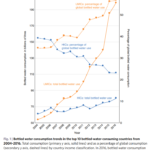 Abstract/Summary: The rapid growth of bottled water use in low- and middle-income countries, and its normalization as a daily source of drinking water, does not provide a pathway to universal access. Generous and sustained investment in centralized and community utilities remains the most viable means for achieving safe water access for all. We recommend that the international development community and LMIC governments accept that full-cost recovery from a low-income customer base is not realistic, and that they actively invest in regulated utilities or community-scale models as the most sustainable options for delivering universal safe water access. This will take time, of course. Consumer confidence in the safety of utility supplied water should be fortified along the way with water quality reports and, perhaps, ‘marketing’ messages. These recommendations are not new, but they bear repeating in an era of explosive growth in, and de facto normalization of, market-driven approaches to ‘safe water for all’. In the meantime, non-tap treatment options that are known to be effective and affordable, but that may achieve only partial uptake, should be subsidized and more aggressively promoted. If, on the other hand, governments and development agencies allow the bottled water sector to continue meeting the rising demand for safe water in LMICs, then access will indeed expand by 2030, but it will not be reliably safe or universally affordable. The SDG for drinking water is a public commitment, and history is clear: public commitments need public investment.
Abstract/Summary: The rapid growth of bottled water use in low- and middle-income countries, and its normalization as a daily source of drinking water, does not provide a pathway to universal access. Generous and sustained investment in centralized and community utilities remains the most viable means for achieving safe water access for all. We recommend that the international development community and LMIC governments accept that full-cost recovery from a low-income customer base is not realistic, and that they actively invest in regulated utilities or community-scale models as the most sustainable options for delivering universal safe water access. This will take time, of course. Consumer confidence in the safety of utility supplied water should be fortified along the way with water quality reports and, perhaps, ‘marketing’ messages. These recommendations are not new, but they bear repeating in an era of explosive growth in, and de facto normalization of, market-driven approaches to ‘safe water for all’. In the meantime, non-tap treatment options that are known to be effective and affordable, but that may achieve only partial uptake, should be subsidized and more aggressively promoted. If, on the other hand, governments and development agencies allow the bottled water sector to continue meeting the rising demand for safe water in LMICs, then access will indeed expand by 2030, but it will not be reliably safe or universally affordable. The SDG for drinking water is a public commitment, and history is clear: public commitments need public investment.
PDF on Publisher Website | PDF on OSF
InnoWat Topic Sheet: [Pro-poor] Payments for watershed services
Authors: Cohen, A.
Publication Year: 2009 | Journal / Publisher: Rome: United Nations International Fund for Agricultural Development
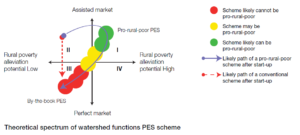 Payments for environmental services (PES) are a means of creating a market in environmental/ecosystem services. They link those who value a given service with those who can provide it. Most early PES initiatives were in Latin America, which remains the region with the most PES schemes, followed by Asia, and lastly Africa (figure 1). Payments for watershed functions seek to link upstream land use and management with downstream water use and management to realize benefits for upstream and downstream participants in the scheme and others in the area – not to mention for the environment. The ideal is a voluntary agreement between at least one buyer and one seller of ecosystem services (or land-use changes presumed to provide an ecosystem service). PES schemes have become increasingly popular with donors over the last few years. Yet despite their widespread application, by their nature they are not primarily intended as a tool for poverty reduction. They may be tailored to this purpose, however. From IFAD’s perspective, the problem is that poor rural people lack the prerequisites for participation in PES. Often, they do not have secure land tenure, rewards are easily usurped by the elite, and they lack the assets (human capital, natural resources) to provide the level of service needed to yield the desired impacts. Part of the solution to this stubborn dilemma may be to eschew PES schemes that simply seek market creation. Rather than clinging to economic principles, develop a variant of PES that builds on the reality faced in rural areas. This means allowing for market support, subsidies and a means of directing PES benefits to poor people – in short, developing pro-rural-poor PES.
Payments for environmental services (PES) are a means of creating a market in environmental/ecosystem services. They link those who value a given service with those who can provide it. Most early PES initiatives were in Latin America, which remains the region with the most PES schemes, followed by Asia, and lastly Africa (figure 1). Payments for watershed functions seek to link upstream land use and management with downstream water use and management to realize benefits for upstream and downstream participants in the scheme and others in the area – not to mention for the environment. The ideal is a voluntary agreement between at least one buyer and one seller of ecosystem services (or land-use changes presumed to provide an ecosystem service). PES schemes have become increasingly popular with donors over the last few years. Yet despite their widespread application, by their nature they are not primarily intended as a tool for poverty reduction. They may be tailored to this purpose, however. From IFAD’s perspective, the problem is that poor rural people lack the prerequisites for participation in PES. Often, they do not have secure land tenure, rewards are easily usurped by the elite, and they lack the assets (human capital, natural resources) to provide the level of service needed to yield the desired impacts. Part of the solution to this stubborn dilemma may be to eschew PES schemes that simply seek market creation. Rather than clinging to economic principles, develop a variant of PES that builds on the reality faced in rural areas. This means allowing for market support, subsidies and a means of directing PES benefits to poor people – in short, developing pro-rural-poor PES.
PDF on Publisher Website | PDF on OSF
InnoWat: IFAD & rural water investments
Authors: Cohen, A. & Nepveu de Villemarceau, A.
Publication Year: 2009 | Journal / Publisher: Rome: United Nations International Fund for Agricultural Development
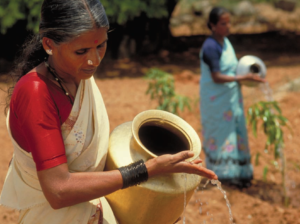 IFAD is currently engaged in over 230 loan operations in 85 countries. About two thirds of that portfolio is related to community-based natural resource management. Poor rural people and their institutions are at the core of this approach. Water is critical to these men and women pastoralists, fishers, farmers, young and old, part- or full-time, urban or rural, indigenous, tribal or otherwise often marginalized people. Itis the key entry point for improving their livelihoods. Water-related interventions are often linked to the building up or restoring of the asset base – and involve many facets and uses. This holistic view is part of the characterization of IFAD’s approach to water interventions in this fact sheet: rather than considering water solely as an input factor in the production chain, we have preferred to follow water throughout rural people’s livelihoods. This approach, combined with a qualitative analysis of the ongoing 2007/08 loan portfolio, yielded a few surprising insights (table 1).Almost half of all projects (45-50 per cent) involve aspects of water resource management at catchment or watershed levels, and hence beyond the immediate household or community level of use.
IFAD is currently engaged in over 230 loan operations in 85 countries. About two thirds of that portfolio is related to community-based natural resource management. Poor rural people and their institutions are at the core of this approach. Water is critical to these men and women pastoralists, fishers, farmers, young and old, part- or full-time, urban or rural, indigenous, tribal or otherwise often marginalized people. Itis the key entry point for improving their livelihoods. Water-related interventions are often linked to the building up or restoring of the asset base – and involve many facets and uses. This holistic view is part of the characterization of IFAD’s approach to water interventions in this fact sheet: rather than considering water solely as an input factor in the production chain, we have preferred to follow water throughout rural people’s livelihoods. This approach, combined with a qualitative analysis of the ongoing 2007/08 loan portfolio, yielded a few surprising insights (table 1).Almost half of all projects (45-50 per cent) involve aspects of water resource management at catchment or watershed levels, and hence beyond the immediate household or community level of use.
PDF on Publisher Website | PDF on OSF
InnoWat: Water, innovations, learning & rural livelihoods
Authors: Cleveringa, R., Kay, M,. & Cohen, A. (Eds.)
Publication Year: 2009 | Journal / Publisher: United Nations International Fund for Agricultural Development
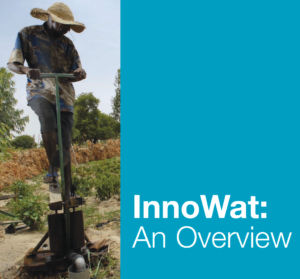 Abstract/Summary: The International Fund for Agricultural Development (IFAD) is a specialized agency of the United Nations dedicated to eradicating poverty in the rural areas of developing countries. Seventy-five per cent of the world’s poorest people, 800 million women, men and children, live in rural areas. Most depend on agriculture to survive. The IFAD team working on agricultural water management and rural infrastructure is developing its operational approach to water and rural poverty (WRP), under the aegis of the project for Learning and Knowledge on Innovations in Water and RuralPoverty (InnoWat). In light of the changing rural context within which poor rural people find themselves, the overall goal of InnoWat is essentially twofold:• strengthen IFAD capacity as a knowledge management broker for development partners interested in WRP, in accordance with IFAD’s mandate; and• provide IFAD country programme managers (CPMs) and their design teams with practical tools for project development, implementation and pro-poor, water related interventions. The team has created the present kit – InnoWat: Water, innovations, learning and rurallivelihoods1 – with the expectation that it will be useful to IFAD CPMs and will enhance IFAD’s comparative advantage with respect to rural poverty reduction and water issues.
Abstract/Summary: The International Fund for Agricultural Development (IFAD) is a specialized agency of the United Nations dedicated to eradicating poverty in the rural areas of developing countries. Seventy-five per cent of the world’s poorest people, 800 million women, men and children, live in rural areas. Most depend on agriculture to survive. The IFAD team working on agricultural water management and rural infrastructure is developing its operational approach to water and rural poverty (WRP), under the aegis of the project for Learning and Knowledge on Innovations in Water and RuralPoverty (InnoWat). In light of the changing rural context within which poor rural people find themselves, the overall goal of InnoWat is essentially twofold:• strengthen IFAD capacity as a knowledge management broker for development partners interested in WRP, in accordance with IFAD’s mandate; and• provide IFAD country programme managers (CPMs) and their design teams with practical tools for project development, implementation and pro-poor, water related interventions. The team has created the present kit – InnoWat: Water, innovations, learning and rurallivelihoods1 – with the expectation that it will be useful to IFAD CPMs and will enhance IFAD’s comparative advantage with respect to rural poverty reduction and water issues.
PDF on Publisher Website | PDF on OSF
Synthesis of strategic approaches: Enhancing pro-poor investments in water & rural livelihoods.
Authors: Cleveringa, R., Kay, M., & Cohen, A.
Publication Year: 2009 | Journal / Publisher: Rome: United Nations International Fund for Agricultural Development
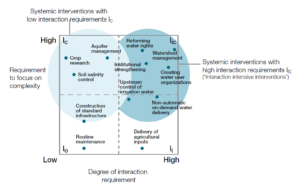 The reduction of hunger and poverty depends on improved access to water for poor rural people. Progress in community water supplies and agricultural water management (AWM), particularly irrigation, is one of the success stories of the twentieth century. However, it is disappointing to learn that AWM, by far the largest consumer of water in developing countries, has had little impact on world hunger and poverty. The experience of agency- and government-led interventions has not been good. They often impose ‘blueprint’ methods that ignore important local issues. A critical gap exists between planning and successful implementation. Approaches focus on what needs to be done, rather than on how to do it, and they ignore the complex interactions among individuals, the state and service providers –as well as their limited capacity to translate plans into practice. If poor rural people are not to be the losers again in the struggle for declining water resources, a new, pro-poor water management strategy is needed. It must focus more on how to do it, while still addressing what to do, where and with whom.
The reduction of hunger and poverty depends on improved access to water for poor rural people. Progress in community water supplies and agricultural water management (AWM), particularly irrigation, is one of the success stories of the twentieth century. However, it is disappointing to learn that AWM, by far the largest consumer of water in developing countries, has had little impact on world hunger and poverty. The experience of agency- and government-led interventions has not been good. They often impose ‘blueprint’ methods that ignore important local issues. A critical gap exists between planning and successful implementation. Approaches focus on what needs to be done, rather than on how to do it, and they ignore the complex interactions among individuals, the state and service providers –as well as their limited capacity to translate plans into practice. If poor rural people are not to be the losers again in the struggle for declining water resources, a new, pro-poor water management strategy is needed. It must focus more on how to do it, while still addressing what to do, where and with whom.
PDF on Publisher Website | PDF on OSF

